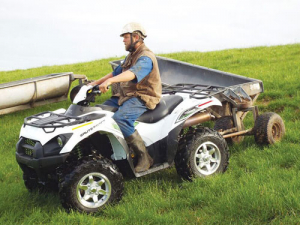Bigfoot comes up trumps
Call them what you will, but UTV’s, side by sides or ROV’s have certainly found a place in much of New Zealand’s rural sector.
 Kawasaki’s Brute Force 750 4x4 is designed for farmers wanting to do heavy-duty jobs quickly and without fuss.
Kawasaki’s Brute Force 750 4x4 is designed for farmers wanting to do heavy-duty jobs quickly and without fuss.
A product's name can give away the maker’s intent, so it’s no surprise Kawasaki’s Brute Force 750 4x4 quad is the flagship of an extended range, designed for farmers wanting to do heavy-duty jobs quickly and without fuss.
Its industry leading 749cc SOHC, V-twin engine develops 37kW at 6750rpm, delivering it smoothly across the rev range; it was never found wanting on a 50km drive by Rural News on a typical Waikato dairy farm.
A dumpy lever allows the choice of hi-lo-park and reverse and easily moves through its gate to select the appropriate ratio in the CVT style transmission. 2WD or 4WD is selected by a rocker switch on the right-hand handlebar, and on the left side a simple lever progressively engages the front differential lock, to ensure part-time momentum in sticky stuff or full lock-up in the really gnarly stuff.
On downhill sections, Kawasaki’s engine brake control uses an electric actuator to lock the drive and driven pulleys in the CVT system to induce engine braking and allow control in all situations.
With the high-performance engine comes impressive ability to stop, thanks to 200mm discs on each front corner, with twin-pot callipers and sealed internal disc at the rear, built into the swing-arm housing and protected against mud, dirt and water.
Riding is a breeze with variable-rate electric power steering which is light at slow speeds and progressively heavier as speed increases. This combines with dual-rate, long travel suspension to ensure a comfortable ride, while taking on all types of terrain with a ground clearance of 240mm.
Living with the machine day-to-day should be easy: it has a front rack of 40kg capacity, the rear 80kg and lots of tie-down points and towing capacity of 567kg. The writer towed trailed meal-bins around the farm on flat and undulating terrain and it was a cinch, the machine always feeling capable and in control. The quad comes pre-wired for a winch.
Also useful is an array of cubbyholes and stowage areas where items can be safely carried, including a waterproof cubby on the left front fender and a box under the headlight that holds two 500ml drink bottles.
Mounted centrally on the handlebars, an automotive style binnacle gives digital information on speed, trip, fuel and temperature, and shows 2WD or 4WD engagement and warning lights for oil and water.
The machine was very easy to ride, but lighter riders may find its weight and power a handful. And we’re not convinced the Diamond White paint job truly suits a typical dairy farm; a more sensible hue might be a camo green or calf scour yellow.
According to the latest Federated Farmers banking survey, farmers are more satisfied with their bank and less under pressure, however, the sector is well short of confidence levels seen last decade.
Farmer confidence has taken a slight dip according to the final Rabobank rural confidence survey for the year.
Former Agriculture Minister and Otaki farmer Nathan Guy has been appointed New Zealand’s Special Agricultural Trade Envoy (SATE).
Alliance Group has commissioned a new heat pump system at its Mataura processing plant in Southland.
Fonterra has slashed another 50c off its milk price forecast as global milk flows shows no sign of easing.
Meat processors are hopeful that the additional 15% tariff on lamb exports to the US will also come off.